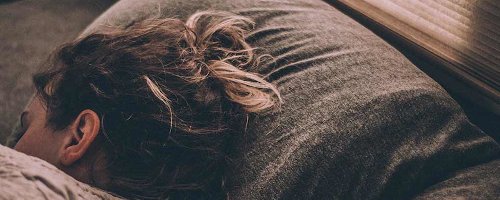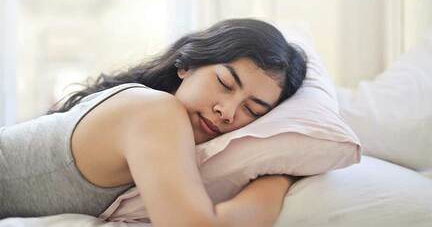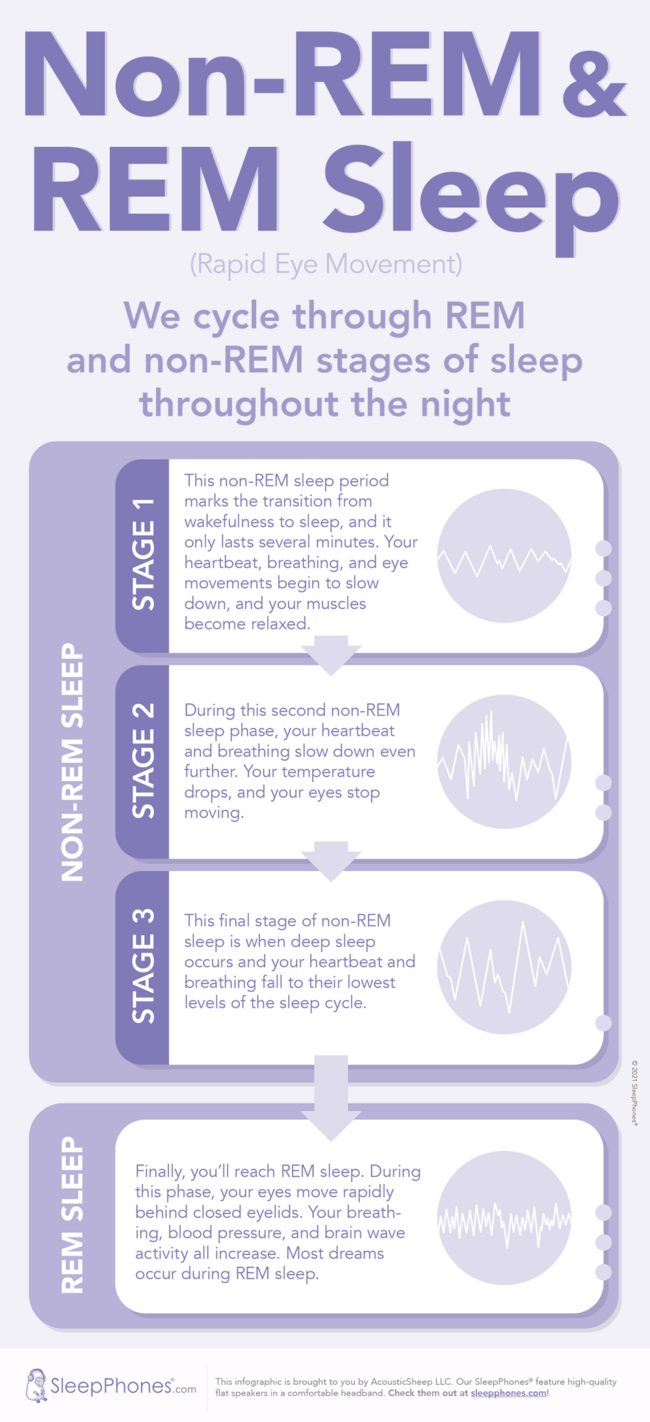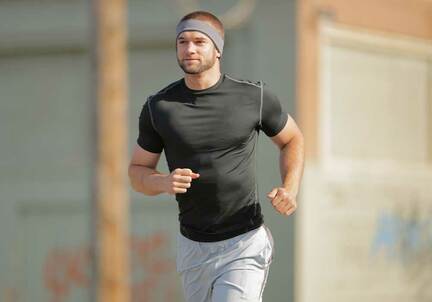What is Deep Sleep, and Can We Use Music to Get More Of It?

We’ve all heard how crucial it is to get enough sleep, and most of us have felt the ill effects of not getting enough of it. Over the long-term, a chronic lack of sleep can lead to hypertension, diabetes, obesity, depression, heart attack, and stroke. On a day-to-day basis, getting enough rest makes us both happier and more productive.
However, did you know it’s not just the quantity of your sleep that matters? It’s a matter of quality, too, meaning you need the right “type” of sleep: deep sleep. To learn more about what deep sleep is, what the benefits are, and whether you can use music to get more of it, read this deep-dive on deep sleep. If you are experiencing difficulty sleeping, seek professional medical advice.
What is Deep Sleep?

Sleep can be categorized in two ways: rapid eye movement (REM) and non-REM sleep, which includes three stages:
- Stage 1: This non-REM sleep period marks the transition from wakefulness to sleep, and it only lasts several minutes. Your heartbeat, breathing, and eye movements begin to slow down, and your muscles become relaxed.
- Stage 2: During this second non-REM sleep phase, your heartbeat and breathing slow down even further. Your temperature drops, and your eyes stop moving.
- Stage 3: This final stage of non-REM sleep is when deep sleep occurs and your heartbeat and breathing fall to their lowest levels of the sleep cycle.
Finally, you’ll reach REM sleep. During this phase, your eyes move rapidly behind closed eyelids. Your breathing, blood pressure, and brain wave activity all increase. Most dreams occur during REM sleep.
We cycle through all the stages of sleep throughout the night. Deep sleep is the third period of non-REM rest and is marked by the slowest brain activity. Because of this, it is also known as slow-wave sleep. During deep sleep, your heartbeat and breathing slow down to their lowest levels during the night. If something or someone wakes you up during this phase, you will most likely feel groggy.

Benefits of Deep Sleep

You spend between 13 and 23 percent of your total sleep time in the deep sleep phase. Despite occupying an average of only 18 percent of your night, reaching the deep sleep phase is a game-changer come daylight.
According to the American Sleep Association, or ASA, deep sleep is when we coalesce new memories. It’s vital for executing short-term memory tasks the next day. Thus, the ASA asserts that people with insomnia don’t perform as well as people without the disorder because their deep sleep cycle is too short and their ability to consolidate memories is compromised. The ASA also says that human sleep deprivation studies indicate that the primary purpose of deep sleep is to allow the brain to recover from the strains of daily activities.
Ways to Increase Deep Sleep

The American Sleep Association says the best way to increase the amount of deep sleep you get is to allow yourself enough total sleep each night. The Association says there is some evidence that vigorous exercise, such as jogging, running, or swimming, can lengthen your deep sleep cycle. If you have trouble falling asleep, however, try to avoid exercising right before bedtime.
Another way to achieve better and deeper sleep is simple, but perhaps easier said than done: put down the doughnuts, cookies, and candy. The National Sleep Foundation says that the more sugar you consume during daytime hours, the more often you’ll wake up during the night. Even if you don’t wake up enough to remember being awake, excess sugar in your body can pull you out of deep sleep and lead to lethargy the next day.
Pink Noise May Lengthen Deep Sleep
A small but encouraging study by Northwestern Medicine found that listening to gentle sound stimulation during the deep sleep phase improved memory recall for people with mild cognitive impairment who are at risk of developing Alzheimer’s disease.
During the study, participants performed better on a memory test after listening to short pulses of pink noise. Pink noise is similar to white noise, but slower and deeper. Roneil Malkani, MD, a physician associated with Northwestern Medicine, stated, “Our findings suggest slow-wave or deep sleep is a viable and potentially important therapeutic target in people with mild cognitive impairment.”
A Frontiers in Human Neuroscience study found a positive correlation between pink noise and sleep stability. The study found that pink noise reduced brain activity in participants and increased the quality of their sleep. Try this 12 hour pink noise track from AcousticSheep:
"I was at first skeptical like a lot of people, but was pleasantly surprised with SleepPhones. The product quality was great and shipping was fast. I primarily use the SleepPhones at night to fall asleep when my partner is snoring. I mostly listen to "pink noise" but the fantastic thing about this device is you can listening to anything you like. The wireless option is a must so you don't have to deal with cords and can use bluetooth. Of all the sleep aid products out there I believe the SleepPhones is one of the best. Worth the money." - Nathan L.
How People Are Using Music and Binaural Beats for Better Sleep
Whether you use music to mask the sounds of a snoring partner or to help to unwind in bed after a busy day, many people have found that meditative and soothing sounds relax their minds and improve their sleep quality.
You may also want to try listening to binaural beats to achieve better sleep. Binaural beats combine two different sound frequencies that your brain interprets as one single tone. This low-frequency tone mimics the slow-wave brain waves of deep sleep.
A small 2018 study showed “significant increases” in the amount of deep sleep participants received when listening to binaural beats compared to a control group who didn’t hear the frequencies. Researchers suggest that people who suffer from a lack of deep sleep because of stress may find that binaural beats improve their quality of rest.
Meditation music and binaural beat creators, “Music for Body and Spirit,” used SleepPhones® sleep headphones to test their track. They said SleepPhones® have “high audio quality and are very comfortable.” See what else people are saying about SleepPhones® by visiting our review page.
"My daughter and I have 4 sets between us and they have revolutionized our 8 hr deep sleep meditations by night and music/podcasts by day. A wonderful, comfortable product that is easy to use, maintain and enjoy! Great customer service too! Highly recommended!" - Belinda W.
"As an RN who works nights, sometimes sleeping during the day can be challenging with the rest of the world awake around you. A friend suggested SleepPhones and I’m glad I got a pair! Super comfy and not awkward to wear . . . try white or pink noise. Overall, I’m a happy (well rested) customer!" - JKY
"I had been toying with the idea of sleep headphones for awhile and after moving into an apartment with a lot of nighttime noise, I took the plunge. After researching I decided to try SleepPhones and all I can say is I wish I got them sooner. They're comfortable and have good sound quality. Definitely worth getting if you need to listen to music, nature sounds, etc. at night!" - Aleesha
SleepPhones®: A Sleeping Aid that Gets Results
If you’re not getting the sleep you need, seek medical help. Ask your doctor if SleepPhones® may be a good solution for you. If you enjoy listening to soothing sounds at night and haven’t yet found the right headphones solution, try SleepPhones® headphones. Our luxuriously soft headbands contain thin, padded speakers to comfortably play any type of music, pink noise, or meditation while you sleep.
Find more about binaural beats at our "Binaural Beats" resource page.
